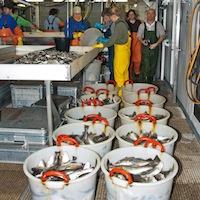
2012-12-19
This past December 2012, the Thünen Institute of Fisheries Ecology (FI) carried out the third CHEMSEA fish sampling campaign in the Baltic Sea onboard the RV Walther Herwig III to study ecological risks associated with dumped chemical munitions and warfare agents.
A team of 12 scientists from three CHEMSEA partner labs (FI, AWI, LEPA) and from the Universities of Galway (Ireland), Berlin, Hannover and Kiel (Germany) visited six sampling sites located at dumpsites of chemical warfare agents (Bornholm Basin, Gotland Deep, and the vicinity of Little Belt) as well as reference areas in the western and eastern Baltic Sea (Arkona Sea, outside Gulf of Gdansk).
Cod (Gadus morhua) was the main target species. A total of 1,400 cod were examined onboard for the presence of a range of externally and internally visible diseases and parasites. In addition, various tissue samples were taken for subsequent lab analyses of contaminant concentrations (including CWA-specific compounds) and biological contaminant effects performed by CHEMSEA partners. Hydrographic parameters were also recorded in order to study their impact on the horizontal and vertical distribution of the fish in the study sites.
A final CHEMSEA fish sampling campaign is scheduled for early September 2013 and will mainly focus on the Bornholm dumpsite. It is anticipated that cod will be more abundant here than during the winter samplings because the Bornholm Basin is the main spawning area of the eastern Baltic cod stock which reproduces in summer.
© CHEMSEA, IOPAN - wszelkie prawa zastrzeżone
Projekt i wykonanie - Virtual Services | Test zgodności W3C: HTML
Powered by: 